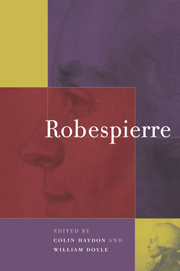1 - Robespierre: after two hundred years
Published online by Cambridge University Press: 14 January 2010
Summary
The seagreen incomprehensible?
Even two centuries after his death, Robespierre can still inspire deep unease or revulsion in France. This is perhaps best shown by the paucity of monuments to the man who was the towering figure of the Revolution. Unlike Danton, whose statue in the Latin Quarter rallies the potrie's youth against the enemy, Robespierre has no statue in the capital. One has to go to Saint-Denis for that – or rather for a large, rather ugly bust, provocatively near the royal basilica. In Paris, there is a Metro station named after him in a working-class district long dominated by the communists; a plaque – recently smashed, but now restored – outside his lodgings in the rue Saint-Honoré; and another in the Conciergerie, erected by the Société des Etudes robespierristes. Even in Arras, his birth-place, the plaque on the house where he lived as a young lawyer is set high up, to prevent vandalism. Unlike Condorcet or Desmoulins, he did not appear on the bicentenary's commemorative stamps. None the less, he was selected for inclusion in a recent poll as one of the figures personifying an epoch in French history. The poll's results revealed that, although controversial, he had a better image than both Louis XIV and Napoleon.
Other polls, in fact, reveal widespread popular ignorance about Robespierre in France (in one conducted in 1988, 29 per cent of those questioned thought he was a Girondin, with only 21 per cent knowing he was a Montagnard). But what is more alarming is the degree to which historians can arrive at diametrically opposed positions on the subject of the Incorruptible.
- Type
- Chapter
- Information
- Robespierre , pp. 3 - 16Publisher: Cambridge University PressPrint publication year: 1999
- 1
- Cited by



